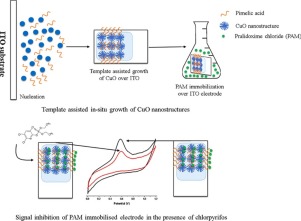Sensors and Actuators B: Chemical ( IF 8.4 ) Pub Date : 2018-01-05 , DOI: 10.1016/j.snb.2018.01.084 Mawada Mohamed Tunesi , Nazar Kalwar , Malik Waseem Abbas , Selcan Karakus , Razium Ali Soomro , Ayben Kilislioglu , Muhammad Ishaq Abro , Keith Richard Hallam

|
This study explores the potential of a newly-developed indium tin oxide (ITO) based electrode for the development of an electro-catalytic inhibition sensor system for organophosphorus pesticides. The sensor relies on the redox signal inhibition of pralidoxime chloride (PAM) immobilised over the pimelic acid functionalised CuO nanostructures grown in-situ over an ITO substrate. The in-situ growth enabled on-pot modification and functionalisation of ITO electrodes with the formation of uniform nanostructures possessing high surface area and excellent interface contact. The versatility of the proposed electrode was evident from its excellent electrochemical characteristics evaluated in comparison to bare and slurry-driven glassy carbon electrodes (GCEs). The high structural uniformity and greater surface coverage achieved by in-situ growth provided a uniform surface environment for electrode-analyte interaction, leading to good inhibition signal sensitivity and repeatability. The developed sensor was successful in detecting chlorpyrifos, fenthion and methyl parathion within the concentration range of 0.01–0.16 μM with signal sensitivity reaching down to 1.6 × 10−9, 2.5 × 10−9 and 6.7 × 10−9 M respectively. Moreover, the proposed sensor demonstrated excellent applicability when tested for chlorpyrifos from vegetable extracts using a standard addition method.
中文翻译:

用于有机磷农药检测的功能化CuO纳米结构:一种非酶抑制方法与纳米级电极工程相结合,可提高电极灵敏度
这项研究探索了一种新开发的基于铟锡氧化物(ITO)的电极在开发有机磷农药的电催化抑制传感器系统方面的潜力。该传感器依靠固定在庚二酸官能化的CuO纳米结构上的pralidoxime chloride(PAM)的氧化还原信号抑制作用,该结构在ITO衬底上原位生长。原位生长能够实现ITO电极的现场修饰和功能化,形成具有高表面积和出色界面接触的均匀纳米结构。与裸露和浆液驱动的玻璃碳电极(GCE)相比,所建议的电极具有出色的电化学特性,因此可以证明其多功能性。通过原位生长获得的高结构均匀性和更大的表面覆盖率为电极与被分析物的相互作用提供了均匀的表面环境,从而导致了良好的抑制信号灵敏度和可重复性。研发的传感器成功地检测出浓度范围为0.01–0.16μM的毒死,、倍硫磷和甲基对硫磷,信号灵敏度低至1.6×10-9,2.5 ×10 -9和6.7×10 -9M 。此外,当使用标准添加方法对蔬菜提取物中的毒死rif进行测试时,所提出的传感器具有出色的适用性。


























 京公网安备 11010802027423号
京公网安备 11010802027423号